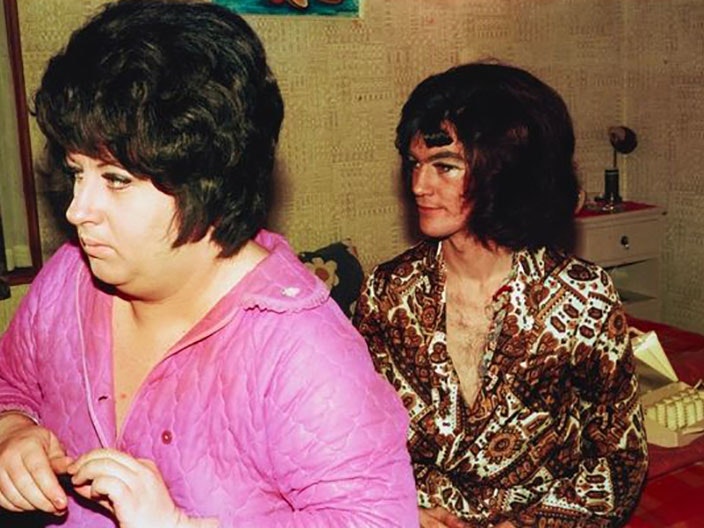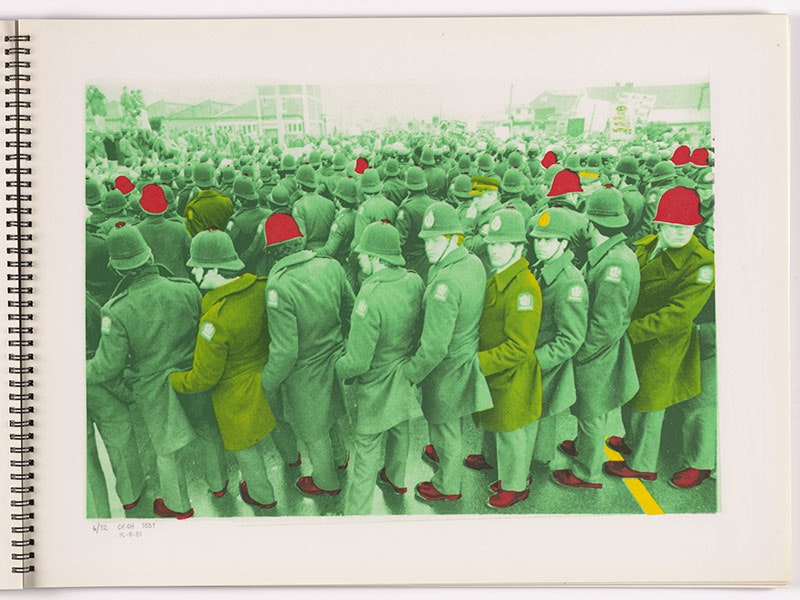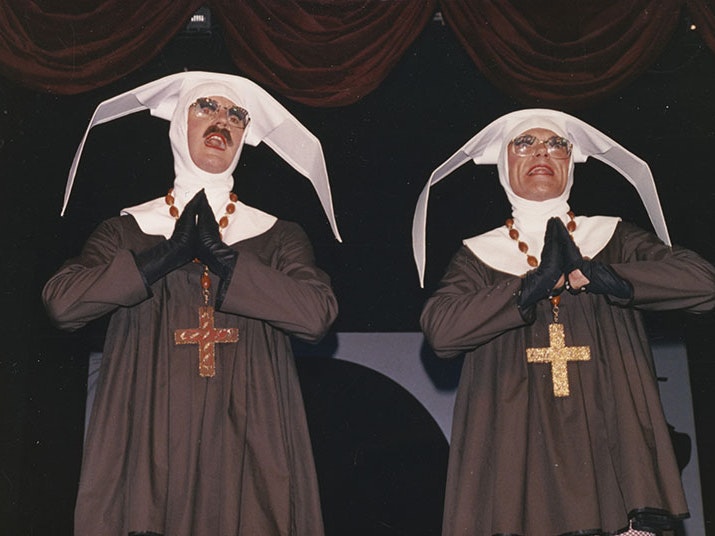
Fiona Clark on Collections Online
See more of Fiona’s work, including ‘Living with AIDS’ and ‘Ngā Whaea o te Moana – Taranaki, 1982’.
Free museum entry for New Zealanders and people living in New Zealand
Open every day 10am-6pm
(except Christmas Day)
Free museum entry for New Zealanders and people living in New Zealand
Fiona Clark is one of New Zealand’s most celebrated art photographers. Working in a social documentary style, Fiona reveals the extraordinary in the communities in which she has lived.
In this essay, Fiona recalls her time as an art student in Auckland in the early 1970s, when she began to take photographs of the people and the night life around her.
When I was 14, I knew I was different. I didn’t fit the norm at Inglewood High School. My father told me that my grandfather had met Amy Maud Bock in Mōkau – the woman who’d famously married another woman in Balclutha in 1909. My grandfather travelled annually to Mōkau, which is right up the coast from where we lived, because he had a relation who worked at the Mōkau boarding house. This is where Amy was staying when he met her.
I’m not sure why my father told me about Amy Bock. My father only said things that he thought were relevant. So maybe he told me because he thought I might be interested or that I should know about her. Whatever it was, I have been fascinated by Amy Bock ever since and have even collected objects from her life, documenting her and her role in our gender history. For example, she was convicted of impersonating a man and served three years in the New Plymouth men’s prison. She always pleaded guilty for every charge. I made a patch out of her guilty signature and I’ve got it embroidered on a jacket. You name it, I’m guilty. I’m guilty of all of it.
Fiona Clark, Diana Adams and friend at Miss NZ Drag Queen Ball, 1975, Auckland. Te Papa (O.043780)
When I was 15 the Govett-Brewster Art Gallery was opening and Leon Narbey, the cinematographer, did his teacher-training placement at Inglewood High School. He took me to the gallery, where his work was part of the opening exhibition. I loved it and he told me about art school.
I knew there was a whole world of art that hadn’t crossed my path and I needed to discover it myself, so I moved to Auckland when I was 16 to study at Elam School of Fine Arts. My parents didn’t discourage me from doing what I wanted to do; in fact I think they found it quite interesting to engage with another generation in a different way. We were not your typical farming family: my brothers had been arrested during Vietnam War protests. (My father was very upset about the police showing up at his house about that, but he swallowed it.) I was the last child in the family – all my brothers and sisters had left home and gone to university – and at school I was put ahead, so I had always been around older students. I wanted out of Inglewood and I think everyone knew it.
Up in Auckland I got a job working the late shift at a little bar on the waterfront called the Ca d’Oro and met a new community of people, many of whom I formed a strong bond with over the next few years, and I wanted to record us hanging out, going to parties or each other’s flats. I felt it was a world people needed to understand and I would be the one to capture it.
I was part of that world, too. I was told I was a ‘femme’ amongst the group. In those days you were either butch or femme. Femmes wore lipstick and dresses and never went to the bar themselves because they were bought a drink. There were even separate butch and femme toilets in lesbian clubs. Labelling was quite simple at that time: you were either a gay man, a gay woman or doing drag. There wasn’t a huge choice. People didn’t want to say homosexual because that meant illegal – you could be arrested for homosexuality back then.
It’s changed so much now. There are so many different labels and groups, but it’s always been that way for me. I just think, ‘Oh, well, that’s that group.’ A lot of the people I photographed I knew well or even flatted with, and I could see how they took on personas when they went out. Nowadays people live those personas 24/7. I think mainly that’s because the law has changed, but also because society wants to label people. People feel a need to say who they are.
Recently somebody asked me how I define myself and I said, ‘Well, I’m just me these days.’ I used to have a saying on my wall: ‘Once I was a tomboy and now I’m a full-grown lesbian.’ One day I crossed out the last half and wrote ‘but now I’m queer’. Even that label will probably change.
Fiona Clark, Donna Terri and friend at Mojo’s, 1975, Auckland. Te Papa (O.043785)
The gay and drag scene around K Road was very small in those days. Mojo’s (on the corner of Queen and Wakefield Streets) was really the only drag performance club. I developed a sense of the history of what I was doing: I would make people private photo scrapbooks, reproducing copies of their one-off polaroids which most photographic labs would have destroyed or censored for being ‘illegal’ or ‘offensive’, in exchange for some of the very early historical images. That’s how I found there had been earlier clubs dating back to the 1960s.
Everything to do with being gay or camp, or expressing sexuality in a different way, was illegal. People were being arrested all the time, mocked and beaten up for their gender, plucked off the street, thrown in the back of cars and ‘dealt’ to. Most of the people in my early photos died young. The deaths were sad and often brutal.
Fiona Clark, Jackie at Mojo’s, 1975, Auckland. Te Papa (O.043118)
In 1973 I was in Elam’s sculpture department as a second-year student. Performance art was taking off and, as I had recorded performances, there was a natural progression to perform myself. I first performed my piece at the art school lecture theatre and then approached Rainton Hastie, the owner of the Pink Pussycat, one of Auckland’s first strip clubs on K Road, who gave us permission to perform and record the art performance there. My friend Raewyn Turner and I turned up as ‘Ruby and Pearl’ and did a strip where we mirrored each other to challenge the idea of gender. The crowd booed us, probably because we didn’t take off enough clothes. We were assertive – we just walked in and took over the club.
The deal with the Pink Pussycat was that I would supply Rainton with images of the performance. I also photographed in K Road’s Las Vegas Club; that work has an embargo on it for many, many years. The Windmill Follies, Pink Pussycat and Las Vegas Club were legendary venues for early performances with both F to M and M to F. The idea of gender in performance was not very well received, and there was no debate around whether it was about gender or sexuality. It was all viewed as illegal anyway, so there was no need to discuss anything.
After that year at art school I moved to the photography department and started to record my friends more. Though 1974 and 1975, I photographed at Mojo’s, the K.G. Club Ball,[1] the Las Vegas Club and at various friends’ parties. In 1974 I photographed a group of friends at a Gay Liberation dance-party at Auckland University, and my friend Karl wrote on the images. Karl was an incredibly bright law student who was nominated ‘The Campiest Queen on K Road’. I always felt a deep sadness about Karl. He never finished his law studies and has since died. Our set of images, ‘Dance Party’, is about being who we were and claiming our identities as real.
People quite often feel confronted by my photographs. The people in them are dignified and they are just as comfortable looking at you as you are looking at them. You’re not looking at an object and the photos are not voyeuristic. The people in them are deeply human – they’re complete and they’re themselves and that’s who you’re looking at. This is how they choose to present themselves to you.
The drag community in the 1970s was very resourceful. They had to be. There was no imported lamé. Ballroom dancers and theatre practitioners within the community had access to colourful cloth, but it was expensive, so people might only have one or two outfits or dresses.
They became very skilled at making costumes and accessories – just as Amy Bock had, when she dressed as a male and wrapped her breasts. Instead of getting breast implants, people would wear Plaster of Paris casts and put netting and high collars over them. It looked like they had real boobs, even nipples. People would make wigs, eyelashes, moustaches. They adapted things. They made wigs sometimes by weaving real hair, sometimes by putting three small wigs together – you could get little hair pieces. Some queens had friends who would make their costumes or their dresses just like a dressmaker would in those days, but the skills were more specific.
For shoes, people would cut off the backs or the straps and redo them with elastic to make bigger sizes. You’d see lots of backless shoes with the heels popping right out, a good inch at the back, but it didn’t matter. Some people made their own shoes or took men’s shoes and put cloth over them, padding the toes. Considering the fashion was for bigger, longer shoes, you’d think the shoes they came up with would be like boats, but they weren’t, they got the look. People were very inventive.
My 1974 series was shown as a part of an exhibition of contemporary New Zealand photography. The images and writing caused an uproar; the Auckland City Gallery closed its doors in March 1976 after public protests over two of the photos. Headlines read ‘“degenerate” photos of K’Rd drag queens cause the closure of the Auckland City Gallery’. A group of 200 churchgoers complained to the council about indecencies being shown on gallery walls and Patricia Bartlett pursued a police prosecution for indecency under the Crimes Act. This was not the only time so-called pillars of the community have objected to my work. There are still people alive who remember a sermon preached about me in the 1970s. The gallery director decided to close the doors.
The works from that exhibition went missing. The gallery says it didn’t lose them but they were last seen on the director’s desk waiting for the police to view them on 3 March 1976. The police didn’t remove the images; someone else did. There’s censorship in the art world for a whole lot of different reasons. Some of the gallery employees at the time probably felt very uncomfortable about the exhibition. It could have caused them to question their own preferences or gender or relationships. There was a whole lot of stuff going on. That is censorship we should own.
It was only in 2016 that the full set of images from that 1974 series were shown again at Artspace on K Road. Their first showing in Auckland marked the 30th anniversary of the passing of the Homosexual Law Reform Act.
Fiona Clark, Carmen at Miss NZ Drag Queen Ball, 1975, Auckland. Printed 2002. Te Papa (O.043777)
I have continued to photograph friends and the group I grew up with. I met Carmen Rupe in 1974 and photographed her throughout her career. She had my photos printed for her Christmas cards and business cards and used to call me ‘my photographer Fiona’. We always kept in contact and I visited her a few times in Sydney. A few years ago she asked me to photograph her for her 70th birthday in Wellington. She was usually the gypsy queen in red but this time she wanted to be a blue mermaid, this beautiful creature who lasted the distance and remembered everything.
I don’t want to present our world as strange. My intent is to give people a voice. The photos say, ‘I am who I am. I’m here. I’m part of your world and I’m going to stay.’ What’s so powerful is the participant’s gaze and directness, but there’s also a huge sadness. You can see the struggle it takes to keep that personal momentum going. I hope these photos make you feel the human connection we all feel when we look at another person. It’s the thread that binds us.
[1] K.G. Club’ may have stood for ‘Karangahape Girls’ Club’ or ‘Kamp Girls’ Club’. The K.G. Club was a lesbian social club founded by Raukura Te Aroha ‘Bubs’ Hetet. See David Herkt, ‘Queen City: A secret history of Auckland’, Public Address (blog), 25 Jan 2013
This essay originally published under the title of ‘Guilty’ in Representing Trans: Linguistic, legal and everyday perspectives, edited by Evan Hazenberg and Miriam Meyerhoff, VUP, 2017 and has been republished courtesy of the Fiona Clark and VUP.

See more of Fiona’s work, including ‘Living with AIDS’ and ‘Ngā Whaea o te Moana – Taranaki, 1982’.

In 1998 Neil Anderson and Michael Eyes gifted a collection of over 20 queer-themed T-shirts to Te Papa from the 1980s and 1990s. Neil Anderson recalls his time as a queer activist before the Human Rights Act of 1993, which made it illegal to discriminate against people on the basis of their sexual orientation.

In this excerpt from Mates & Lovers, Chris Brickell explores the vibrant world of drag culture in New Zealand, when drag ‘jumped off the stage and into the streets’.